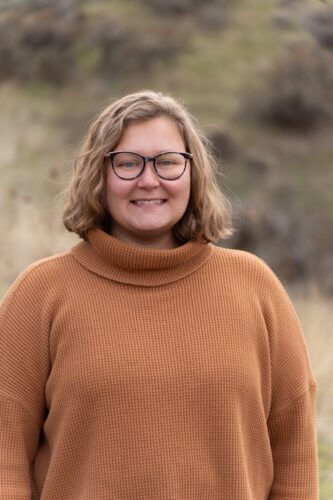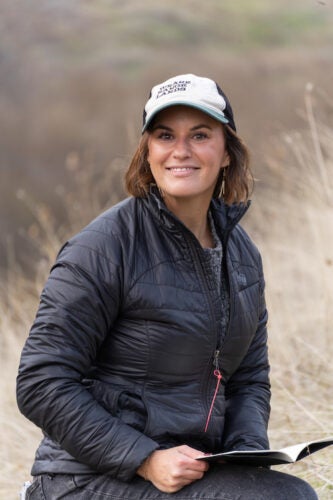Fifth-year doctoral candidates Haley Netherton-Morrison and Molly Levy are trailblazing research in the West’s rural communities with two newly awarded US Department of Agriculture National Institute of Food and Agriculture predoctoral fellowships. These students are both affiliated with the Ecology, Evolution and Behavior doctoral program and the Human-Environment Systems program.
These two-year fellowships of nearly $120,000 each will empower Levy and Netherton-Morrison’s goal to analyze the complex relationships between Western lands and the diverse community of stakeholders who live in, work on and manage those lands. The goal of both researchers’ work is to promote resilient rural agricultural communities in the face of change.
Haley Netherton-Morrison
Faculty mentor: Kelly Hopping

“I’m looking at how landscapes and communities are changing and how the ways that people relate to those places and those landscapes affect what they want to see happen as those spaces change,” Netherton-Morrison explained.
Netherton-Morrison hails from Fishers, Indiana, and her research involves Owyhee, Blaine and Teton Counties in Idaho. With support from her fellowship, she wants to explore how rural residents relate to and value their community and landscape, and how they view and experience community and landscape change.
As forces such as population growth, development, and land use change continue to alter the face of the West, Netherton-Morrison’s research will help discover where community members’ perspectives differ and align. This research will be integral to informing future community planning and land management.
For example, some community members may embrace the new cultural amenities, such as restaurants and entertainment, that growth and development provide. However, others may be concerned about the loss of a strong sense of community or a long-time local business. Each community member has a different perspective on and experience with these changes, yet they are all still part of shaping policy through voting and community involvement, which reflect their values and concerns.
To do that, she visits rural communities and interviews residents to understand what the community and land means to them, how they relate to them, and how they think about the changes and challenges they face. These interviews will go on to inform later parts of the project, including inviting community members to use maps to highlight areas of importance to them, and to rank pre-written statements about their community and landscape based on their level of agreement or disagreement with them.
“There’s a very social science focus to my research, so I’m using a combination of quantitative and qualitative methods,” Netherton-Morrison said. “And it’s about finding people where they are: post offices, public parks, trails or coffee shops. Overall, I really do find that people are interested in sharing their perspectives. It has been a lot of really good conversations about what makes these rural communities special and how change may be affecting the things they care about.”
Molly Levy
Faculty mentor: Vicken Hillis

Levy hails from upstate New York, but her research dives into the Thunder Basin National Grassland of northeastern Wyoming. This national grassland supports a wide range of uses, including livestock grazing, environmental and wildlife conservation, and natural resource extraction. As such, it is of great importance to many stakeholders, including the US Forest Service, federal and state government agencies, conservation non-governmental organizations, private landowners and ranchers.
Consequently, the area is a unique jigsaw puzzle of land ownership types, land uses and interests, all of which shape this western landscape.
For example, one stakeholder group in the region, ranchers, support their operations through the use of permitted grazing in the grassland, and intergenerational ranching families may lease the same federal grazing allotments for decades. However, conflict can arise when the management goals of permittees misalign with overall management policies established by USFS, and finding a resolution that satisfies multiple stakeholder groups can become complicated.
“In recent years, there has been a lot of conflict surrounding management of prairie dogs. In Wyoming, they’re classified as an agricultural pest, and landowners can use tools to control populations. But the forest service classifies prairie dogs as a sensitive species, and so they limited the management options on public lands,” Levy said. “So it becomes really tricky when ranchers are worried about the threat prairie dog expansion poses to their livelihoods, conservationists are looking to expand protections for prairie dogs, and the forest service is put in the middle to sort out what kinds of management will meet these different needs, while still sustaining a healthy grassland.”
To conduct this research, Levy is collecting and analyzing data from multiple critical sources. In addition to conducting interviews with different types of stakeholders, she is also analyzing the recorded outcomes of federal decisions made during the National Environmental Policy Act. Since the 1980s, there has been a gradual shift from ‘top-down’ decision making by federal agencies to a more balanced, collaborative process with stakeholder groups. In Thunder Basin, collaborative decision-making is exemplified by a multi-stakeholder working group that was formed to provide input to USFS on changes in grassland management policy.
One question she wants to be able to answer is “What stakeholder perspectives are actually being addressed in these decisions, and is collaboration actually changing the way these agencies are making decisions over time?”
Lastly, Levy will work with the district office in Douglas, Wyoming, to use historical grazing records to examine the broader context of how land use has changed in Thunder Basin across the past century. This component of the study presents a challenge because the records–namely rancher’s permits describing the duration of land use, animals grazed, etc–date back to the 1930s.
“These records are kind of jumble,” Levy said. “A lot of them are handwritten, they have notes scrawled over them, and the actual format of the document changes over time. So even though this type of grazing permit data exists in district offices across the country, they’re difficult to use in their current state. I’ve been working on first digitizing these forms to try and extract the relevant data and see how, and if, grazing has changed over time in Thunder Basin. Overall, I’m hoping to understand how grazing is changing in the West in response to changes in management policy.”
With a better understanding of historical management, current land managers can use this information to inform strategies that promote sustainable western landscapes.